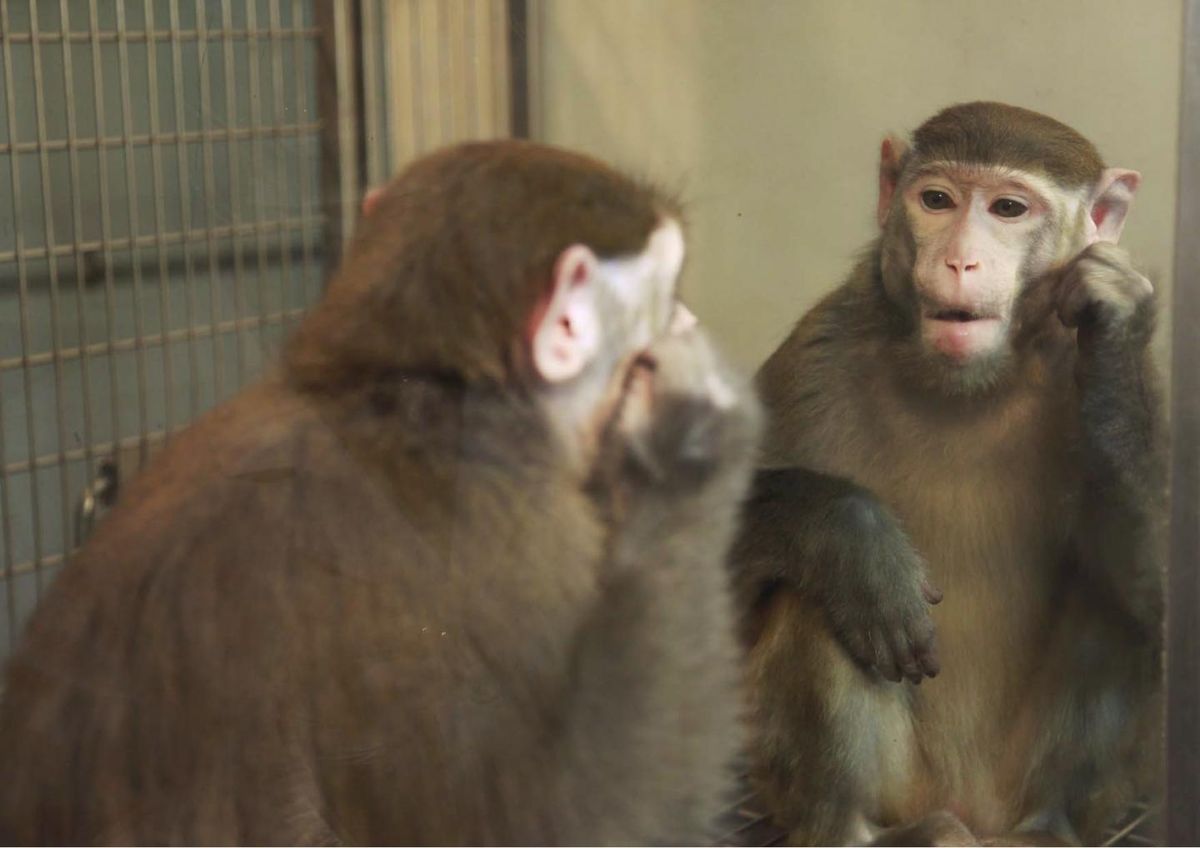Can Monkeys Learn to Recognize Themselves in the Mirror?

Humans have it. So do chimpanzees, bottlenose dolphins, Asian elephants and even magpies. The ability to recognize oneself in the mirror is known as self-recognition, and monkeys weren't thought to be able to do it — until now.
A group of researchers claims they have trained rhesus monkeys to learn to recognize their reflections in a mirror.
"The monkey's brain has the basic 'hardware' for self-recognition, but [the animal needs] some special 'software' from training to get this ability," Neng Gong, a neuroscientist at the Chinese Academy of Sciences in Beijing and co-author of a new study published today (Jan. 8) in the journal Current Biology, told Live Science. [See Video of Monkey Looking at Itself in the Mirror]
In humans, mirror self-recognition is thought to be a sign of empathy, so finding it in monkeys has important implications.
Laserlike focus
In the new study, Gong and his team placed monkeys in front of a mirror and shined a high-powered laser light directly on the animals' faces that caused a feeling of mild irritation. Later, they shined a low-powered laser on the monkeys' faces that caused no irritation. After two to five weeks of training, the seven monkeys in the study learned to touch the spot in front of the mirror.
The researchers also showed the monkeys video mirror images of their face with a virtual mark on it, and the animals touched the dot. The researchers concluded that the animals had passed the so-called mark test.
Sign up for the Live Science daily newsletter now
Get the world’s most fascinating discoveries delivered straight to your inbox.
Gordon Gallup Jr., an evolutionary psychologist at the State University of New York at Albany, who was not involved with the research, developed the "mark test," which is essentially the gold standard for measuring whether an animal possesses self-recognition. [8 Humanlike Behaviors of Primates]
X marks the spot
In the original version of the test, an odorless, nonirritating dye is placed on an animal's face, which can only be seen in a mirror. If the animal touches the mark after seeing itself in the mirror, but not when the mirror is gone, it is said to have passed the test.
From great apes to elephants, a variety of different species have passed the mark test. But previously, despite numerous attempts by Gallup and other scientists, monkeys had consistently failed to recognize themselves.
A study in 2010 led by Luis Populin, a neuroscientist at the University of Wisconsin-Madison, found that rhesus monkeys with head implants showed self-directed behavior in front of a mirror — examining parts of their bodies they couldn't normally see, such as the insides of their mouths or their genitals — but the animals did not pass the mark test.
In the new study, most of the monkeys also engaged in self-directed behaviors, such as touching the mark on their face and then looking at or smelling their fingers. Just like the monkeys in Populin's study, Gong's animals used the mirrors to examine parts of their bodies they couldn't normally see.
The monkeys' self-recognition abilities lasted for at least one year, Gong said. Monkeys that were not trained by the researchers failed the mark test, he said, and the animals could not learn the ability from other monkeys.
But not all scientists buy the new findings.
Gallup, who developed the mark test, called the study "fundamentally flawed," because it merely demonstrated that the animals could be trained to do something, not that they understood what they were doing.
"I bet I could train a pigeon to pick the correct answers to the Graduate Record Examinations (GRE)," Gallup told Live Science. "If the pigeon got [the maximum GRE score], would it be qualified for Harvard University?"
Creatures with feelings, or trained monkeys?
In humans, self-recognition is sometimes considered a hallmark of empathy, which is thought to involve a similar brain mechanism, Gong said. If monkeys can be trained to develop self-recognition, perhaps they have the mental capacity for empathy as well, scientists say — though so far, there is only anecdotal evidence to support this idea. (For example, The Guardian published a video of a monkey at a train station in India that attempts to revive another monkey that had been electrocuted on the tracks, by biting the stunned animal's head and splashing it with water.)
The researchers noted that the findings may provide hope for people with mental disabilities who are sometimes unable to recognize themselves in the mirror, such as individuals with developmental disorders or Alzheimer's disease. Perhaps with training, these people could regain the self-recognition ability, the researchers said.
Populin, who was not involved in the study, praised its findings. "It supports our conclusions," he told Live Science. Most of the time, monkeys don't recognize themselves in mirrors, he said, but "this study shows they have the ability to learn."
But Gallup remains convinced that Gong's monkeys were just blindly following their training. "I don't think there's a shred of compelling, reproducible evidence for self-awareness in rhesus monkeys," he said.
Follow Tanya Lewis on Twitter. Follow us @livescience, Facebook & Google+. Original article on Live Science.










